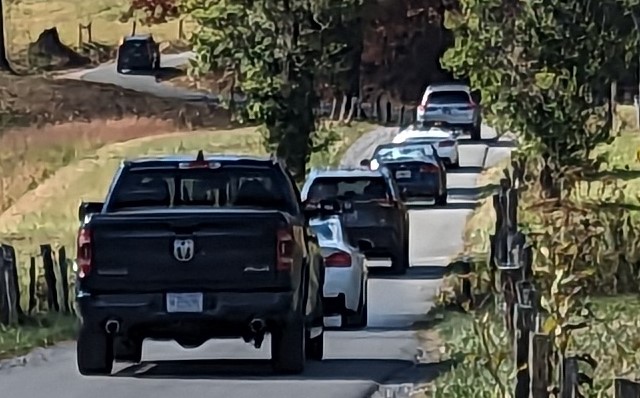
Editor’s Note: This essay is part of a series written during Railback’s stay in the park from June 22 to August 4, 2023.
I try to bike Cades Cove Loop every day, but this afternoon I hesitate at the entrance. The line of vehicles extends from beyond the information kiosk to down the road as far as I can see. My eyes sting from the afterburn of Canadian fires. The humid summer sky casts a sickly orange light. The air smells burnt.
This is a bad day for looping.

I’ve spent many days riding alongside sedans, SUVs, and trucks here, even joking that navigating this traffic on a bicycle is my daily dance with death. But I don’t see other bicycles today—a red flag. I go anyway, finding an open space to drop in between the bumpers.
My ride, a 1996 Trek 6500 mountain bike (ridiculously retro), works well here; I can ease off the road, hit the gravel, and pass the metal herd. When the road narrows, often on the uphills, I’m stuck behind a chugging pickup, staring at the big tailpipe and huffing diesel fumes with my Canadian smoke. I read a lot of license plate numbers.
You must appreciate the absurdity of bad looping. One fellow leans out his window and offers me a cold beer (I decline, imagining how the writer in residence would like a ranger’s citation for drinking a Bud Light on the road).
My eyes and lungs tell me it’s too much today, and I cut my ride short by taking Hyatt Lane. Gravel dust kicks up from vehicles in both directions. Two guys kick back in the bed of a truck, listening to blaring country music. Another pickup hurls by with a young woman in a bikini in her lounge chair; I’m not sure what she sees through her dark sunglasses. She may as well be poolside in Vegas.
At the Dan Lawson cabin I stop to take a long pull from my water bottle. My throat feels like it’s coated with acid. A young female black bear happens along the split rail fence nearby, absolutely electrifying the people there. Some folks run up too close, crowding the bear, trying to record the ultimate YouTube video. A mother screams, grabs up her young children, and flees to the safety of her van. Sublimely, the bear ignores everyone.

A volunteer or ranger will soon show up and do the difficult work of keeping people and bear safely separated. As I flee, the vehicles back up into a massive “bear jam.” A ranger will be tied up in traffic control here.
Ahead, thanks to the mob-up behind me, the road is clear. I guiltily thank the bear. The crowd back at Lawson’s are understandably awed and excited, just as I was when we had young children and cycling seemed impractical. From our car, chugging along in line, we happily enjoyed the beauty of Cades Cove.
Yet pedaling away, coughing with tears in my eyes, it seems that even in the great wilderness of Great Smoky Mountains National Park, there are a lot of people. And though the rangers and volunteers do an incredible job with the visitors, how many more millions will the park sustain?
On a day of bad looping, this question grows to a global scale.
You worry about the old feedbacks in nature, the dependable cycles of life and seasons—the vast interdependency of environmental systems—that served us so well. American literature leaned on the predictability of nature, whether it was generous or cruel (from our point of view). Nature of the Holocene informed our great books, as a sampling of Emily Dickinson, Herman Melville, Willa Cather, or John Steinbeck demonstrates.
Bad looping permeates the books of the 21st century; for now our literature tends to reflect the Anthropocene.
“It is worse, much worse, than you think,” David Wallace-Wells opens his bestselling nonfiction account of climate change, The Uninhabitable Earth. His book surveys how the environmental feedbacks have altered so that slowing or stopping climate change becomes more difficult. Polar melt means less ice to reflect heat and more sea water to absorb it, propelling even faster melt. More frequent and hotter fires force trees to expel carbon rather than bank it, accelerating warming and in turn causing more fire.

As the variety of feedbacks alter along with the climate that our species has depended on, Wallace-Wells predicts frightening human responses: mass migrations, political instability, economic decline, and wars over dwindling resources.
Contemporary literature imagines an environment that has veered away from Homo sapiens. Cormac McCarthy’s most famous novel, The Road, portrays a post-apocalyptic world that no longer sustains life as we know it.
Jesmyn Ward’s National Book Award-winning novel, Salvage the Bones, is set during Hurricane Katrina. Her menacing portrayal of the environment departs radically from the American tradition: Mother Nature becomes “the mother we will remember until the next mother with large, merciless hands, committed to blood, comes.”
Returning to my apartment, pondering bad looping, I can’t help but notice my Fiat’s two exhaust pipes. And that night, working in my office, I think about where the electricity comes from that powers my lights, air conditioning, and the computer I’m writing on.
Coyotes often pass by Second Acts, and on this night I imagine one standing in the road, peering through the window into my brightly lit room. Perhaps, thinking for all the other animals prowling the darkness, she watches me and wonders, What are you doing?
Subscribe to get the latest posts sent to your email.
The Great Smokies Welcome Center is located on U.S. 321 in Townsend, TN, 2 miles from the west entrance to Great Smoky Mountains National Park. Visitors can get information about things to see and do in and around the national park and shop from a wide selection of books, gifts, and other Smokies merchandise. Daily, weekly, and annual parking tags for the national park are also available.